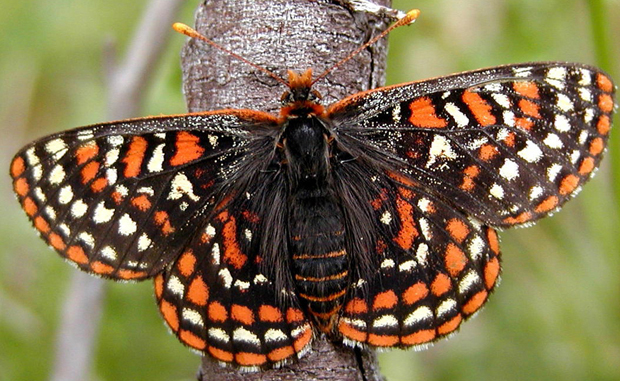 Stewardship Needs of Taylor’s Checkerspot Butterfly
Stewardship Needs of Taylor’s Checkerspot Butterfly
The Taylor’s checkerspot Euphydryas editha taylori is one of Canada’s endangered species, found nowhere else in Canada but Denman Island. The survival of this butterfly in Canada depends on the caring stewardship of Denman landowners.
This butterfly makes few demands on landowners’ plans for their property. The larvae or caterpillars eat native and introduced weedy plants that grow in shallow wet spots. The butterflies nectar on almost any flowering meadow plant. Most of the Denman Checkerspot’s life-cycle is spent as caterpillars, from late June to late April, and they live in and adjacent to moist open depressions. The butterflies are seen in open areas nectaring, mating and laying eggs from late April to early June.
Thus the stewardship requirements for landowners to conserve this endangered species’ future are relatively simple. Stewards could retain open areas with sunny moist ditch-like areas that have some of the caterpillars’ summer food plants e.g. marsh speedwell Veronica scutellata. These moist sections probably need some protective debris or plants such as stumps, shrubs or sedges, nearby, so that the butterflies can shelter from predators while mating and laying their eggs. The weedy food species may need some disturbance occasionally to allow them to grow. We expect that during the late fall and winter, the caterpillars probably need a protected dry spot to curl up in for hibernation and it is possible that they hibernate in groups. We think that these protected dry spots are probably not too far from their moist spring-foraging areas. So slightly-raised south-facing mounds, with some protective cover, adjacent to wet ditches are probably ideal. In the early spring, the caterpillars have been seen eating plantains, which are abundant in most grassy areas.
On Denman, many of the small sub-populations of Checkerspots are currently in clearcuts with wet sedgy areas. Some of the wet areas are small wetlands and others are old ruts left by logging equipment. These clearcuts seem to provide the wet habitat with the suitable caterpillar-food plants, such as marsh speedwell; the adjacent dry areas to hibernate; the suitable protective cover-debris/plants; as well as the flowering nectar-plants, such as forest-edge wild strawberry or open-land opportunistic daisies. Unfortunately these clearcuts are not a solution to the Checkerspot’s future survival, as the clearings will re-grow as forests that will shade out the checkerspot habitat.
In the last few years Checkerspot butterflies have wandered into many fields and openings around Denman. We are hoping that the Checkerspots will set up small breeding populations in sites that landowners are planning to keep open, thus securing a future for these butterflies. One farm has a very active breeding population already and we are hoping that some other landowners will be able to mimic the type of habitat seen on this farm. The Conservancy is planning to try to create some Checkerspot habitat on the Settlement Lands in conjunction with the adjacent active open-land agricultural activities. We are unsure of the role of disturbance in Checkerspot habitat, but it is certain that openings are important and also that these butterflies can travel. So hopefully we can create sufficient suitable areas in Denman fields to keep future generations of Denman’s charismatic endangered species alive.
photo: J. Balke

